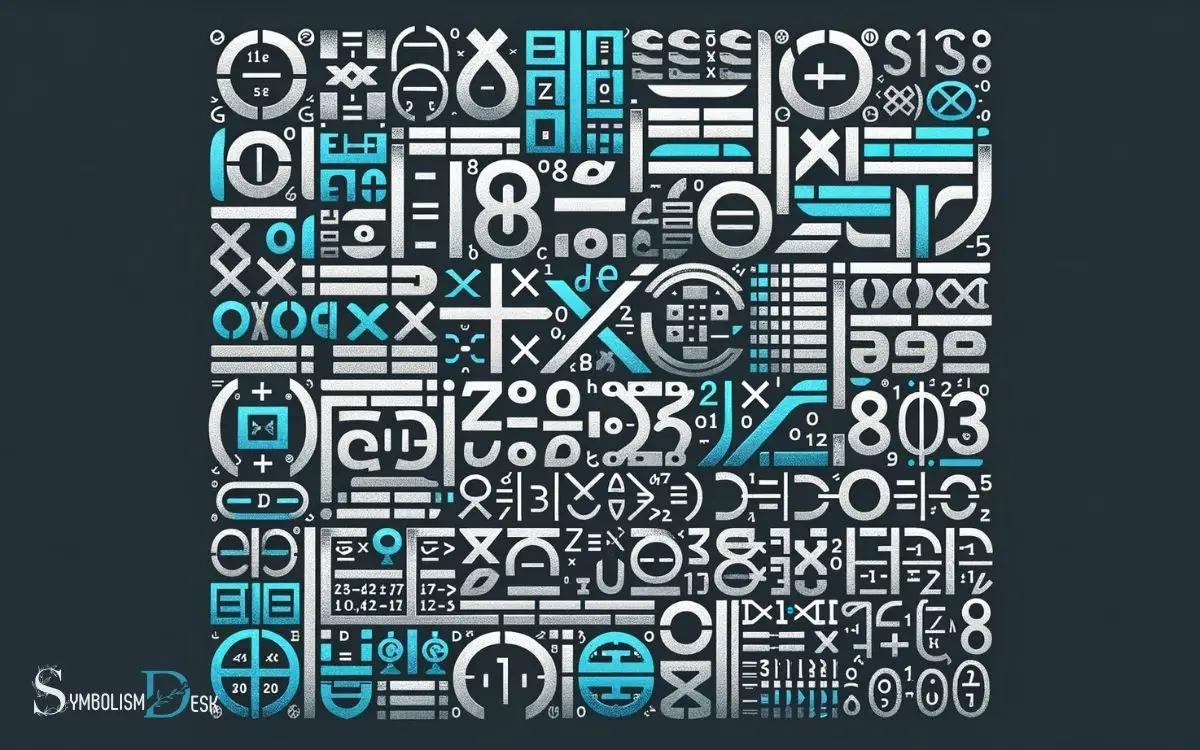Ascii Code for Math Symbols: Mathematical Symbols!
The ASCII code system encompasses a collection of numerical values that correspond to letters, punctuation marks, and various symbols, including mathematical symbols.
For instance, the ASCII code for the plus (+) symbol is 43, and the code for the equals (=) sign is 61. These codes facilitate the encoding and decoding of mathematical expressions across different digital platforms and programming environments.
ASCII codes for math symbols are integral for representing mathematical operations in digital form. They are particularly important in programming, where such symbols are used in algorithms and data processing.
ASCII codes are limited to 128 characters, which include control characters, numbers, letters, and a subset of commonly used symbols.
- Example: The ASCII code for the asterisk (*) symbol, which often represents multiplication, is 42.
Bullet Point:
- Plus (+) symbol: ASCII code 43
- Minus (-) symbol: ASCII code 45
- Equals (=) sign: ASCII code 61
Mastering ASCII codes for math symbols enhances precision in coding, data analysis, and digital communication.

Key Takeaway
ASCII Codes for Mathematical Symbols – Complete Reference Table
| Symbol | ASCII Code | Description |
| #ERROR! | 43 | Plus sign |
| – | 45 | Minus sign |
| * | 42 | Asterisk/Multiply |
| / | 47 | Forward slash |
| #ERROR! | 61 | Equals sign |
| % | 37 | Percent sign |
| < | 60 | Less than |
| > | 62 | Greater than |
| & | 38 | Ampersand |
Importance of ASCII Codes for Math Symbols
The importance of ASCII codes for math symbols lies in their ability to facilitate the representation and communication of mathematical expressions within digital environments.
ASCII (American Standard Code for Information Interchange) provides a standardized way to encode characters, including mathematical symbols, for digital communication.
This is crucial for ensuring that mathematical expressions can be accurately represented and shared in various digital platforms, such as emails, documents, and websites.
By using ASCII codes, mathematicians, scientists, and educators can seamlessly convey complex mathematical concepts and equations in a format that is universally recognized and easily interpreted by computers.
This standardization not only enhances the clarity and precision of mathematical communication but also enables the seamless integration of mathematical content into digital tools and platforms.
Basic Math Symbols and Their ASCII Codes
Let’s explore the ASCII codes for some basic math symbols. We will discuss the ASCII codes for the plus sign and the minus sign, shedding light on their representation in computer systems.
Understanding these codes can be helpful for anyone working with mathematical expressions in programming or other technical fields.
Plus Sign: ASCII Code
Discussing the ASCII code representation of the plus sign within the context of basic math symbols and their respective ASCII codes presents an opportunity to clarify its digital encoding.
The plus sign, denoted as ‘+’, has an ASCII code of 43. In computer systems, the ASCII code 43 is used to represent the plus sign in various programming languages, text editors, and communication protocols.
This digital encoding allows for the seamless inclusion of the plus sign in mathematical expressions, programming logic, and data processing.
Understanding the ASCII code for the plus sign is fundamental for ensuring accurate and consistent representation in digital environments.
Minus Sign: ASCII Code
The ASCII code for the minus sign, represented as ‘-’, is 45. The minus sign is a fundamental math symbol used for denoting subtraction and indicating negative numbers. Its ASCII code allows computers to interpret and display this symbol accurately.
Here are some key points about the ASCII code for the minus sign:
- ASCII code 45 corresponds to the standard hyphen-minus character used for the minus sign in computing.
- It is different from the ASCII code for the en dash (ASCII code 150) and the em dash (ASCII code 151), which are used for different purposes in typography.
- The minus sign is a vital component of mathematical expressions and programming languages, where its accurate representation is crucial for precision and clarity in written and displayed equations.
ASCII Codes for Advanced Math Symbols
The ASCII codes for advanced math symbols are crucial for representing complex mathematical expressions in digital formats. Understanding the common math symbol codes enables users to efficiently input and display mathematical equations in various applications. For example, knowing the ASCII code for the integral symbol allows users to easily type it into a word processing program or incorporate it into a website. Additionally, having access to alt code explanations can help users troubleshoot any issues they may encounter when inputting math symbols, ensuring their equations are accurately represented. Understanding these codes is essential for anyone working with mathematical notation in a digital environment.
By using math symbols in their ASCII code form, individuals can seamlessly incorporate sophisticated mathematical notations into their work.
Common Math Symbol Codes
This section presents the ASCII codes for common advanced math symbols. When working with advanced math symbols, it’s essential to have quick access to their ASCII codes.
Here are the ASCII codes for some common advanced math symbols:
Logical Symbols:
- ∧ (Logical AND): 8743
- ∨ (Logical OR): 8744
- ¬ (Logical NOT): 172
Set Theory Symbols:
- ∈ (Element of): 8712
- ∉ (Not an element of): 8713
- ⊆ (Subset of or equal to): 8838
Calculus and Analysis Symbols:
- ∫ (Integral): 8747
- ∂ (Partial derivative): 8706
- ∇ (Nabla): 8711
Knowing these ASCII codes can be immensely helpful for typing or programming mathematical expressions accurately.
Using Math Symbols
By utilizing the ASCII codes for advanced math symbols, one can accurately incorporate mathematical expressions into documents or code.
Advanced math symbols, such as integrals (∫), summations (∑), and square roots (√), are essential for conveying complex mathematical concepts. Using their corresponding ASCII codes, these symbols can be seamlessly integrated into various digital platforms.
For instance, in word processing, programming, or typesetting, these symbols enhance the display of mathematical equations and formulas.
Understanding and utilizing the ASCII codes for advanced math symbols not only improves the visual representation of mathematical content but also ensures precision and clarity in conveying complex mathematical ideas.
Therefore, familiarizing oneself with these ASCII codes can significantly benefit individuals working with advanced mathematical expressions in digital formats.
Using ASCII Codes in Digital Communication
Using ASCII codes in digital communication allows for precise representation of mathematical symbols and equations. This is particularly useful in various digital platforms and documents.
Here are some key points to consider:
- Universality: ASCII codes can be universally interpreted by different computer systems, ensuring consistent display of math symbols across various devices and software.
- Efficiency: Incorporating ASCII codes for math symbols reduces file sizes and facilitates efficient data transmission, as it requires less memory and bandwidth compared to other encoding methods.
- Compatibility: ASCII-based math symbols are compatible with a wide range of programming languages and markup formats, making them suitable for diverse digital communication needs.
Incorporating math symbols in programming with ASCII codes provides a seamless way to express mathematical concepts in digital environments, ensuring clarity and accuracy in communication.
Incorporating Math Symbols in Programming With ASCII Codes
Incorporation of math symbols in programming with ASCII codes facilitates precise representation and seamless communication of mathematical concepts in digital environments.
By utilizing ASCII codes, programmers can easily integrate math symbols into their code, enhancing the clarity and functionality of mathematical operations within software applications.
Below is a table showcasing some commonly used math symbols and their corresponding ASCII codes:
| Symbol | ASCII Code |
|---|---|
| + | 43 |
| – | 45 |
| * | 42 |
| / | 47 |
Integrating these symbols using ASCII codes allows for the seamless expression of mathematical operations, enabling programmers to develop robust and mathematically accurate software solutions.
Tips for Remembering ASCII Codes for Math Symbols
When memorizing ASCII codes for math symbols, it’s essential to establish mnemonic techniques for efficient recall and application.
Here are some tips for remembering ASCII codes for math symbols:
- Create visual associations: Associate the ASCII code with a visual representation of the symbol, such as drawing the symbol next to its corresponding code.
- Use acronyms or phrases: Formulate acronyms or phrases using the symbol’s name or shape and its ASCII code to aid in retention.
- Practice regularly: Consistent practice and application of the ASCII codes will reinforce memorization and make it easier to recall when needed.
Understanding these mnemonic techniques can greatly assist in memorizing ASCII codes for math symbols and enhance their practical application in programming and other contexts.
ASCII Codes for Commonly Used Math Operators
The ASCII codes for the commonly used math operators provide essential representations for arithmetic and logical operations in programming and digital communication.
Some commonly used math operators and their corresponding ASCII codes include addition (+ – 43), subtraction (- – 45), multiplication (* – 42), division (/ – 47), and equality (= – 61).
These codes are fundamental in encoding mathematical expressions and equations in computer programming, enabling the manipulation of numerical values and the execution of mathematical operations.
Additionally, these ASCII representations facilitate the seamless exchange of mathematical data in digital communication, ensuring that mathematical symbols are accurately interpreted and processed across different computing systems.
Understanding and utilizing these ASCII codes for commonly used math operators is imperative for developers, programmers, and individuals working with mathematical expressions in digital contexts.
Exploring Lesser-Known Math Symbols and Their ASCII Codes
Exploring lesser-known math symbols and their ASCII codes enhances the understanding of specialized mathematical notations in digital contexts, providing comprehensive insights into the encoding and manipulation of these symbols in programming and communication systems.
Math Symbols and Their Meanings
- ASCII Code: 236
- Description: Mathematical symbol for “much less than.”
Rarely Used Mathematical Operators
- ASCII Code: 197
- Description: Represents a mathematical operation not commonly found in standard arithmetic.
Specialized Set Notations
- ASCII Code: 246
- Description: Denotes a specific mathematical set with unique properties.
This exploration not only deepens the grasp of mathematical concepts but also facilitates their application in various technological domains.
Understanding these lesser-known symbols and their ASCII codes is crucial for accurately representing and processing mathematical expressions in digital environments.
Conclusion
Understanding ASCII codes for math symbols is crucial for digital communication and programming.
From basic math symbols to advanced mathematical notation, ASCII codes provide a standardized way to represent these symbols in various digital platforms.
By familiarizing oneself with these codes, individuals can effectively incorporate math symbols into their work and communication. So, why not take the time to learn and master these ASCII codes for math symbols?






